Moldings and wall paintings
1. GENERAL CONTEXT
Art Nouveau not only occurred in painting, sculpture and architecture, but also in the applied or decorative arts. This integrative concept includes the design of architectural elements with which to embellish both the interior of the buildings and their facades. Along with iron, carpentry, ceramics or glass, the use of moldings and wall paintings proliferated in the constructions of the time.
The most inspiring decorative themes come mainly from the natural world, along with exotic motifs from other cultures and idealized female images.
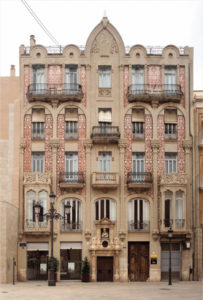
Architects and master builders found an environment favorable to novelties, putting them at the service of their clients’ desire for luxury and cosmopolitanism. For them they designed buildings with a great abundance of ornamental elements, of the most diverse origins: quilting, plaques, pilasters of various shapes, friezes, balustrades, corbels, vases, pinnacles, and a long etcetera of details and sculptural ornaments made of plaster and natural and / or artificial stone.
Another frequent feature is the use of polychrome decorations, either by contrasting materials, or by the inclusion of different paints between the mouldings and the continuous coatings of the facades.
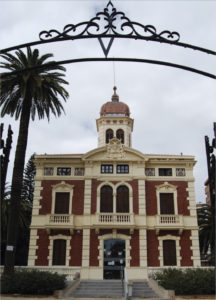
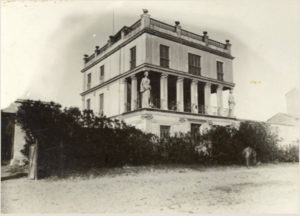
2. PRODUCTION / CHARACTERISTICS
In the Cabanyal neighbourhood, Modernisme adopted a popular and genuine language. Both the mass production of architectural elements in plaster and artificial stones, as well as the realization of murals from climbs and stencils, favored its popularization.
Among the most frequent moldings and sculptural elements made of plaster and/or artificial stone, we must distinguish between those located on the facades or those that embellish the interior of buildings.

MOLDINGS
Facades
+ Brackets under balconies, among which the female figures and floral motifs stand out.
+ Contour of openings, usually in a tone that contrasts with the background of the façade.
+ Cornices and pilasters, of classical influence.
+ Balustrades and finishes of facades, intended to cover the slopes of the roofs.
+ Coats of arms with acronyms or dates, located on the finishes or above the main doors.
Interior
+ Vaulted with doors, shaped like an arch or lintel. + Ceilings that covered the slabs.
+ Perimeter cornices.
+ Panels, located in the center of the ceilings.
MURAL PAINTINGS
The location of the Cabanyal-Canyamelar neighborhood means that most of the coatings and elements of its facades are aimed at protecting them from moisture and sun. This means that wall paintings decorate, above all, the interior of buildings. However, we also find some elements that look outside.
Facades
+ Finishes. We find examples of initials and some stylized figurative paintings – such as the lions located in the house on Calle Escalante –.
Interior
+ Borders at the height of the plinth or cornice.
+ In ceilings and domes.
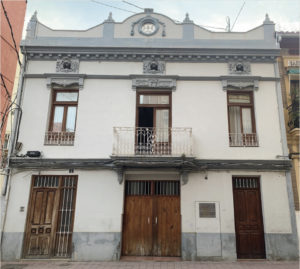
3. EXAMPLES OF THE CABANYAL
MOLDINGS
Parish of Christ the Redeemer (C/ de la Reina, 96)
Located between two buildings that gain in height, we find walking along Carrer de la Reina, the façade of this original parish. Founded in the mid-s. In the nineteenth century, this neo-Gothic building dates from around 1900. Its style makes it a unique case in the neighborhood, where the use of moldings give it that aspect that brings it closer to flamboyant Gothic.
The façade is of simple composition, with two doors framed by conopial arches decorated with plant motifs and topped with floral crosses. In the central part there is a rose window with openwork tracery, also topped by a decorated conopial arch. The upper part is topped by a stepped profile in which pointed trefoil arches are inserted, covered by red tile roofs. From the flanks rise two pinnacles also with plant motifs.
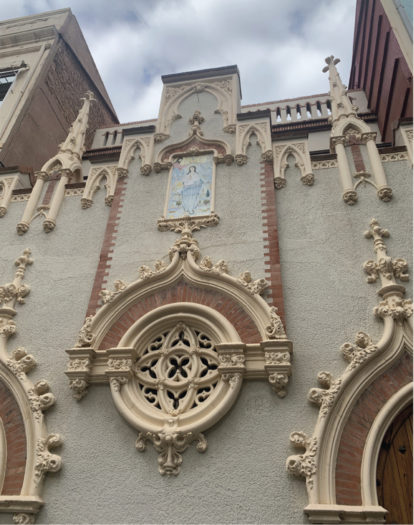
The parish actively participates in the Maritime Holy Week of Poblats Marítims, one of the main signs of sociocultural identity of these neighborhoods and declared, therefore, Intangible Cultural Heritage.
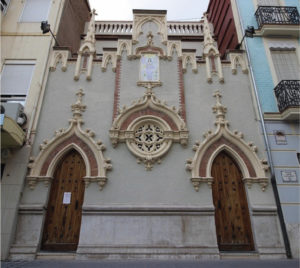
“La Fabriqueta”. Eclectic building on Pintor Ferrandis Street, 34.
This residential building is one of the best known in the neighborhood, since it was built in 1927. With a great profusion of ornamental elements, it does not follow a literal reading of the regionalist neo-baroque eclecticism, popular in Valencia in the 20s. It is a clear example of the free interpretation of architectural styles in the Cabanyal-Canyamelar.
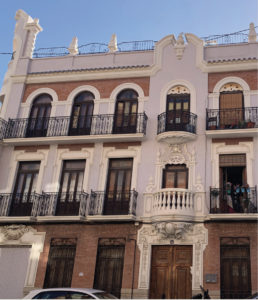
With façades on three different streets, the main one faces Calle del Pintor Ferrandis and is structured in three parts: the central one, narrower, with a main door framed with plant motifs, volutes and central shield. Above this stands a circular balcony with balustrade, the opening of which is also vaulted with acrotera shaped like vases. Above, we see a new circular balcony with iron railing; and finally, a finish with multiple cornice, crowned by a vase. From this central element, the rest of the façade unfolds, repeating the same compositional scheme of lintel balconies on the first two floors, and arched on the last. But the most characteristic are the rounded corners and its two viewpoints with large windows divided by pilasters. And at the top, the complex is topped by semicircular arches framed by Solomonic columns and pediment with a central eye.
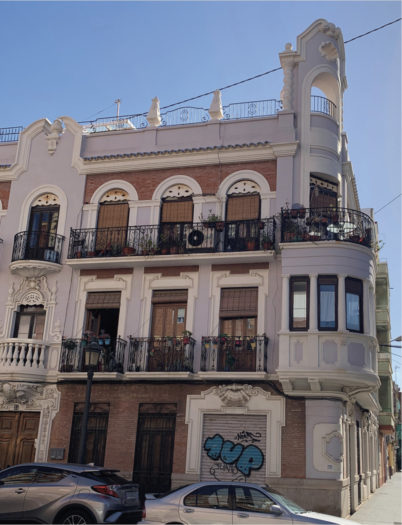
PAINTINGS
House of Bulls sundial
The U-shaped sundial, located on one side of the House of Bulls, was already made in 1895, when the building came into operation. It was located on the upper floor of the south façade, following an orientation towards the southwest. According to oral sources, another sundial was painted on the north side but was not successful, given its orientation.
The numbering in Roman numerals is painted on a sailor blue background; and the gnomon is placed on an astral yellow background. With the movement of the sun, it indicates the hours and half hours covering a cycle of twelve hours (from 6.30 to 18.30). On the Gnomon Wand, the date 1895.
Despite the long process of degradation of the Casa dels Torus, in 2011 it was possible to recover the clock with the repainting work and it has become one of the symbols of the Cabanyal-Canyamelar neighborhood.

Los Angeles Street, 25
This building draws attention to the mouldings in the shape of lion’s heads that we find on its façade. Another, in the form of a shield, informs us of its construction date: 1889.
Thanks to the artistic process carried out during the years 2007-2008 by the artists Patricia Gómez and Ma Jesús González, we can cross the border that supposes the façade, to discover the paintings of its rooms. With their registration, we verify the intention to dilute what is public and private in the homes of the Cabanyal. In its facades the taste for the decoration and ornamentation of the interior spaces is projected, especially in the rooms that occupied the house on the upper floor. On the ground floor, the large gates gave access to shops related to the activity generated by the old Cabanyal market – located in today’s Plaça del Doctor Llorenç de la Flor.

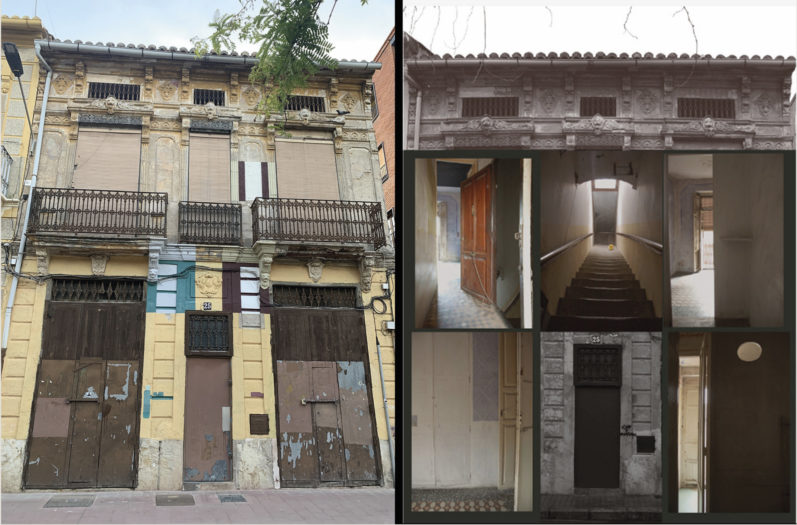
Text 2